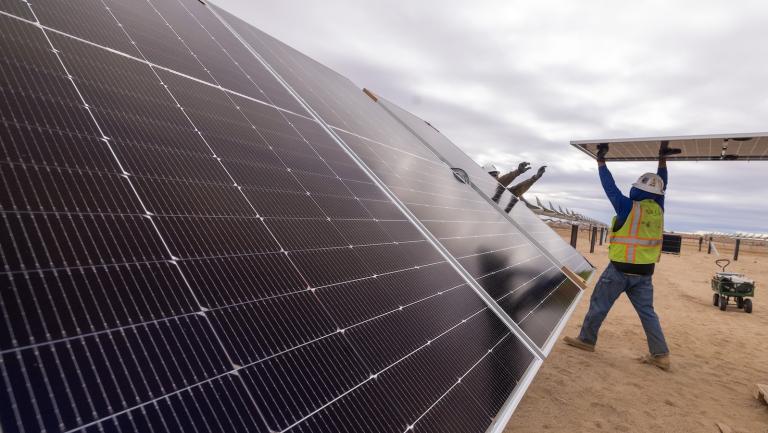Renewable energy advocates are enthused by Barack Obama’s call to double the production of clean, domestic energy and create three million jobs in the sector, but they don’t think he’ll be able to pull it off unless he backs two changes to the tax code — changes they say will help spur millions more jobs in the wind and solar industries.
Right now, the tax credits for solar and wind energy (yes, the much-beleaguered credits that were finally slipped into the October bailout of the financial markets) are not refundable — that is to say, a producer only gets the money back if it makes a profit. Problem is, given the economic downturn, not many renewable energy companies are making money. That means the tax credits aren’t helping them. The solar and wind industries would like the renewable tax credits to become refundable, which would offer rebates even to companies that aren’t making money.
Obama has said his stimulus plan would create nearly half a million jobs through clean energy investments, but neither the investors nor the lenders who would normally provide the upfront funding for start-up renewable projects are feeling confident enough to do so right now. It also doesn’t help that some major financial backers of renewable projects — like Lehman Brothers — have gone under in recent months.
“Lehman goes away, and many other banks have suffered major losses because of the sub-prime crisis, and because they’re suffering these huge losses they don’t have much tax liability,” Chris O’Brien, head of market development and government relations for North America at the Swiss company Oerlikon Solar, told Grist. “They don’t need more losses, so their appetite for investing in solar projects has gone way down at a point in time where the interest in and the need for tax equity has gone way up.”
Another idea floating around the Hill is for the stimulus plan to put $10 billion into a “National Clean Energy Lending Authority” that could lend to renewable projects and help support homeowners who want to retrofit. Reps. Chris Van Hollen (D-Md.) and Zach Wamp (R-Tenn.) wrote a letter to Obama this week asking him to support something like this. “The current financial crisis has not only thrown us into recession, it has significantly derailed or killed off virtually every alternative energy project in the pipeline, making renewable energy yet another victim of the economic fallout,” they wrote.
“We applaud President-elect Obama’s aggressive goal of doubling the production of alternative energy in the next three years. Wind energy is ready to do its part, but we face a major obstacle in this economic downturn,” said Denise Bode, the president of the American Wind Energy Association, in a statement. “We can continue to grow through this difficult period only if the new Administration and the 111th Congress act immediately to make renewable tax incentives refundable so they can work as they are intended to — even in the current financial context. This is a critical first step to building the new, clean energy economy.”
Renewable industries are asking for the credits to be made refundable for eight years, which should allow the capitol markets time to restabilize. According to a recent study by Navigant Consulting, the solar sector alone will could spur 440,000 permanent jobs and $325 billion in private investment by 2016 through the ITC.
“Our industries have become powerful economic engines in the U.S., each year creating tens of thousands of new jobs and billions of dollars in economic investment. And we have the potential to put millions more Americans back to work,” said Rhone Resch, president of the Solar Energy Industries Association (SEIA). “But due to the recession, projects are now being put on hold, factories are closing and workers face potential layoffs unless Congress refines the tax credits now so they work as originally intended.”
The groups have also asked Congress to adjust the ITC from 30 percent to 50 percent for residential and small scale commercial installations, and for state and local governments to be allowed to provide financing for projects without reducing their federal ITC eligibility. Some are also hoping the administration will create a similar 30 percent tax credit for manufacturing in hopes of offsetting the incentives offered in places like China and Germany for companies that create manufacturing facilities. The credit could be used for the purchase of the manufacturing equipment needed to produce things like wind turbines and solar panels here in the U.S.
“This very robust opportunity for long-term growth in the United States, supported by the long-term ITC, supported by the RPS now in over 30 states, supported by the growing number of programs like the California Solar Initiative,” said Oerlikon Solar’s O’Brien. “However, there’s a question of where those modules will be produced. We think that there’s an opportunity now in the stimulus package to include a tax credit not just for the installation of PV systems, but also for investment in renewable manufacturing.”
O’Brien, who was chairman of SEIA from 2003 to 2008, said a manufacturing tax credit would influence his company as they make plans about where to open manufacturing facilities. He estimated that such a credit would create more than 300,000 new solar-industry jobs in the U.S.
“I know that measure would result in the very near term in some decisions to site manufacturing facilities for thin-film photovoltaics here in the U.S. as opposed to in China or India or other places,” said O’Brien. “That kind of a measure is also something that is consistent with regional incentives that are often made available for companies that are located in some of the countries that have attracted a lot of manufacturing investment like Germany and China.”
How feasible these tax changes are remains to be seen. The battle over getting even a short extension to the credits lasted nearly all of 2008, thanks to a highly contentious battle between the House and Senate over how to pay for the new credits. Renewable advocates say the ITC change wouldn’t actually be a tough sell, since Congress has already agreed to the expenditure — the credits just aren’t being utilized. A manufacturing tax credit might be a bit harder, but it could be popular with rust-belters who want new manufacturing jobs for their regions.
Environmental groups are hoping that a stimulus measure like this could be part of a down-payment on longer-term clean energy policies.
“We are excited to work with the administration on their plan to double renewable energy capacity in America,” said Sean Garren, clean energy associate for Environment America. “A first step to making that happen will be finding a way to make the renewable energy tax credits usable through these tough economic times. Making sure clean, renewable energy continues to grow and thrive will help us to solve global warming, as well as creating thousands of new jobs in rural counties and manufacturing cities.”



